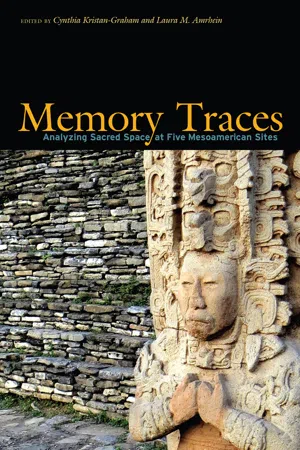
Memory Traces
Analyzing Sacred Space at Five Mesoamerican Sites
- English
- ePUB (mobile friendly)
- Available on iOS & Android
Memory Traces
Analyzing Sacred Space at Five Mesoamerican Sites
About this book
In Memory Traces, art historians and archaeologists come together to examine the nature of sacred space in Mesoamerica. Through five well-known and important centers of political power and artistic invention in Mesoamerica—Tetitla at Teotihuacan, Tula Grande, the Mound of the Building Columns at El Tajín, the House of the Phalli at Chichén Itzá, and Tonina—contributors explore the process of recognizing and defining sacred space, how sacred spaces were viewed and used both physically and symbolically, and what theoretical approaches are most useful for art historians and archaeologists seeking to understand these places.
Memory Traces acknowledges that the creation, use, abandonment, and reuse of sacred space have a strongly recursive relation to collective memory and meanings linked to the places in question and reconciles issues of continuity and discontinuity of memory in ancient Mesoamerican sacred spaces. It will be of interest to students and scholars of Mesoamerican studies and material culture, art historians, architectural historians, and cultural anthropologists.
Contributors: Laura M. Amrhein, Nicholas P. Dunning, Rex Koontz, Cynthia Kristan-Graham, Matthew G. Looper, Travis Nygard, Keith M. Prufer, Matthew H. Robb, Patricia J. Sarro, Kaylee Spencer, Eric Weaver, Linnea Wren
Frequently asked questions
- Essential is ideal for learners and professionals who enjoy exploring a wide range of subjects. Access the Essential Library with 800,000+ trusted titles and best-sellers across business, personal growth, and the humanities. Includes unlimited reading time and Standard Read Aloud voice.
- Complete: Perfect for advanced learners and researchers needing full, unrestricted access. Unlock 1.4M+ books across hundreds of subjects, including academic and specialized titles. The Complete Plan also includes advanced features like Premium Read Aloud and Research Assistant.
Please note we cannot support devices running on iOS 13 and Android 7 or earlier. Learn more about using the app.
Information
1
Introduction
Populating Sacred Places
Table of contents
- Cover
- Title Page
- Contents
- List of Figures
- Preface: “Memory Traces”
- 1. Introduction: Sacred Spaces as Subject and Study in the Mesoamerican Landscape
- 2. Passing through the Center: The Architectural and Social Contexts of Teotihuacan Painting
- 3. Where Rulers Are Made: Spaces of Political Legitimacy at Tula and El Tajín
- 4. Building Memories at Tula: Sacred Landscapes and Architectural Veneration
- 5. The House of the Phalli and the Constitution of Sacred Space through Gender Performances at Chichén Itzá
- 6. Establishing and Translating Maya Spaces at Tonina and Ocosingo: How Indigenous Portraits Were Moved, Mutilated, and Made Christian in New Spain
- 7. Final Thoughts: Space, Place, Ritual, and Identity in Ancient Mesoamerica
- List of Contributors
- Index